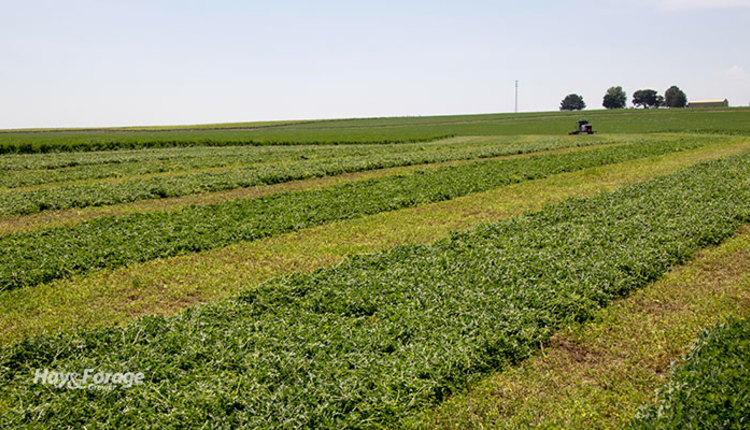
There’s never been a haymaker who couldn’t improve on their craft. The opportunities to enhance forage yield, quality, and persistence are nearly endless. Whether you’ve already started cutting or are still waiting, Amanda Grev offers this bevy of suggestions in the University of Maryland’s Agronomy News to improve this year’s hay quality ledger.
Harvest at the correct maturity stage
“The single most important factor affecting forage quality is the stage of maturity at the time of harvest,” notes the extension pasture and forage specialist. “This is especially true in the spring when forages are growing and maturing rapidly.”
Target the onset of cutting at the boot stage for grasses or late bud to early bloom for legumes. For legume-grass mixtures, base your cut-time decision on the maturity of the grass, which usually mature earlier than legumes in the spring.
Cut early, wide, and high
In humid regions, maximize curing time by mowing in mid- to late-morning after the dew has dried off. This will allow for more drying time before sunset. Grev notes that maximizing exposure to sunlight and wind will result in faster dry down and reduced plant respiration during hours of darkness.
“When mowing, set the mower to make as wide of a swath as possible, ideally at least 70% of the cut width,” Grev writes. “Maximizing the swath width shortens the wilting time by exposing a larger portion of the forage to direct sunlight, which leads to faster drying and preserves more digestible dry matter.”
She also recommends paying attention to cutting height and avoid cutting hayfields too close. For alfalfa, leave 2 to 3 inches of residual. Cool-season grasses generally require no less than a 4-inch cutting height.
“Not only will this result in improved stand persistence, earlier regrowth, and sooner subsequent cuttings, but the stubble will help to elevate the swath and promote airflow and rapid drying,” Grev explains.
Monitor moisture
Ted or rake forage above 40% moisture; this helps to reduce leaf loss, especially for legumes. Make sure rakes are properly adjusted to avoid picking up soil. Using rakes that handle the hay gently or slowing the speed of the rake are also ways to further minimize leaf loss and maintain forage quality.
Bale hay at 15% to 18% moisture to inhibit mold growth and reduce heating. Hay that is too wet — above 20% moisture — is prone to excessive heating and is subject to having high concentrations of heat-damaged, indigestible protein. Hay that is excessively dry will have greater leaf loss, which reduces forage quality.
Time cuttings
“Appropriate timing includes not only harvesting at the ideal forage maturity but also timing your cutting schedule for optimal growth based on seasonal weather conditions,” Grev notes. “For example, completing the first cutting in a timely manner allows time for adequate regrowth and a good second cutting prior to the onset of the hot summer months. A nitrogen application (for grasses) following first harvest can help with this by stimulating forage regrowth.”
Grev recommends allowing cool-season hayfields to go into the summer with at least 5 to 6 inches of regrowth. Doing so will provide shade to the plant crown and moderate the soil surface temperature, reducing soil moisture losses.
Fall hay cuttings need to be scheduled to allow stands enough time to regrow and replenish root carbohydrate reserves prior to winter dormancy.
Feed the crop
Quality forage can’t be achieved without a sound soil fertility program. Grev suggests that a sound forage system entails providing adequate nutrients to the crop while also monitoring soil pH, soil compaction, nutrient removal rates, and overall nutrient status.
“High-yielding cuttings of hay remove substantial amounts of nutrients from fields, making a balanced fertility program essential for optimizing hay production,” Grev says. “Take the time to soil test and apply nutrients and lime according to soil test results. Avoid using “complete” fertilizers like 10-10-10, which commonly overapply phosphorus and underapply potassium.”
Keep it covered
Finally, Grev cautions to preserve forage yield and quality during storage. Store hay off the ground and preferably under cover. Weathering losses are largely the result of hay bales wicking moisture from the ground.

